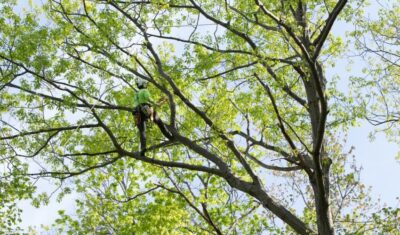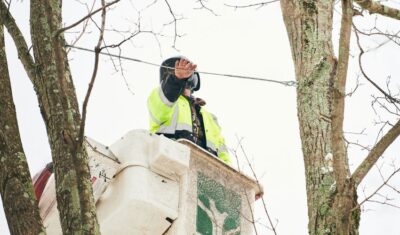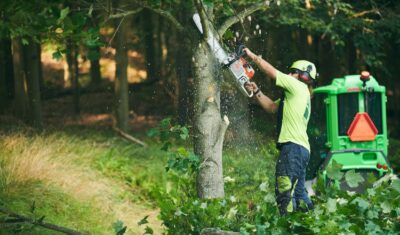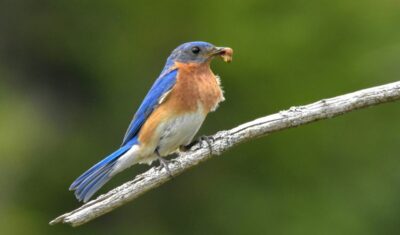Tree trunks are the backbone of your landscape, but they’re often overlooked until a problem becomes severe. As a property owner in northeast Ohio, you know that healthy trees add value and beauty to your home. But how can you tell if your tree’s trunk is in trouble?
This guide will walk you through 12 common tree trunk issues, from decay and pest infestations to structural problems like co-dominant stems. You’ll learn how to spot early warning signs, what steps you can take to address these issues, and when it’s time to call in a professional arborist.
By understanding these trunk problems, you’ll be better equipped to maintain the health and safety of your trees, protecting your property and preserving your landscape for years to come.
Key Takeaways
- Trunk issues can compromise tree health and safety, potentially risking property damage and personal injury.
- Common trunk problems include decay, leaning, co-dominant stems, splitting bark, pest infestations, diseases, cankers, included bark, cavities, and girdling roots.
- Early detection and prevention are crucial for maintaining tree health. Regular inspections and proper tree care practices can help identify and address issues before they become severe.
- Many trunk problems can be prevented through basic tree care, including proper planting, pruning, watering, mulching, and protecting trees from mechanical damage.
- For severe trunk issues, consult with a professional arborist as improper treatment can further harm the tree. Some problems may require specialized techniques like cabling, bracing, or in extreme cases, tree removal.
1. Trunk Decay
Tree decay is a common issue that compromises the structural integrity and health of trees. It often results from fungal infections that break down the wood, making the tree weak and vulnerable to collapse.
Fungus will enter the tree through open wounds. Most trunk wounds are caused by humans, either from vehicles, lawn mowers, or improper pruning. Trunk decay can also stem from soil borne diseases like armillaria root rot and phytophthora.
Because decay happens under the surface, it can be easy to miss until it’s too late.
Signs of tree trunk decay include:
- Soft wood: Areas of the trunk may feel spongy or soft to the touch.
- Crumbling or peeling bark: Bark that peels or falls off easily may be a sign the tree is decaying.
- Mushrooms: Fungal growth on or near the trunk is a clear indicator of internal decay.
- Hollow sounds: Tapping the trunk and hearing a hollow sound can signify decayed wood inside.
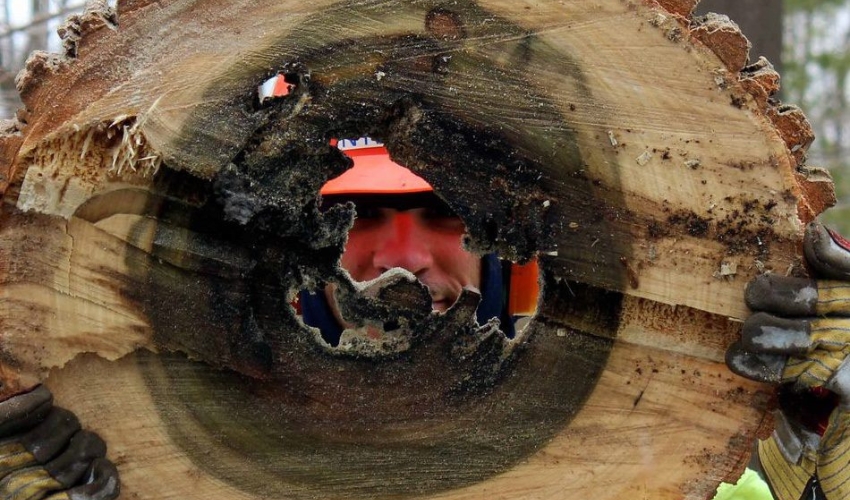
Addressing Trunk Decay
If the decay is limited to a small area around a wound, the tree can likely recover on its own. It will compartmentalize the area, blocking it off from the rest of the tree to prevent the spread of the fungal infection. The health and vigor of the tree, as well as the specific species, will determine the tree’s ability to compartmentalize and wall off the decay.
However, if the affected area is too large, or if the decay comes from a serious fungal disease, the decay is likely to spread throughout the tree. Have your tree inspected by a professional arborist to determine the extent of the damage and to see if the tree can be saved or if it should be removed before it becomes a hazard.
Preventing Tree Trunk Decay
Preventing decay is much more effective than trying to fix it. You can do this by:
- Preventing tree wounds: Keep lawn mowers, string trimmers, and vehicles away from valuable trees. Remove turf grass around the base and add mulch and/or shrubs, so you don’t need to mow too close to the tree.
- Prune properly: Many wounds occur from improper pruning techniques. Learn how to prune effectively (just outside the branch collar) or hire professional arborists to prune your trees.
- Proactive tree care: Ensure trees are well-watered, properly mulched, and pruned regularly to reduce stress and enhance their natural defenses against diseases, pests, and decay.
- Regular inspections: Regularly check your trees for early signs of decay and other issues.
2. Leaning Trunk
Leaning trees can indicate underlying issues such as root damage, poor planting, or soil erosion. However, not all leaning trees are a hazard.
Many tree species can grow at a pretty severe angle as long as the individual trees have done so their entire life. Many young trees will begin growing at an angle as they reach for the light, known as phototropism.
Leaning trees are usually only an issue when a tree that has typically grown straight suddenly develops a new lean. This will often happen after a severe weather event or if the tree is in standing water, when roots can become loose. Because trees have not developed this way, they are at an increased risk of falling over and should be addressed, especially if the tree is close to a building, road, sidewalk, driveway, or area frequented by people.
How to Fix a Leaning Tree
First, determine why a tree is leaning. Is it young and struggling against strong winds? Is there root rot? Are the roots girdling (strangling) the trunk? Is the soil saturated or frequently inundated with standing water? Many trees lean due to root or soil problems, which need to be addressed first.
Otherwise, for very young trees, gently push the tree back to its upright position and stake it securely with flexible ties to allow some movement, promoting strong root growth. Unfortunately, this may cause damage to the roots or the trees, so continue to monitor tree health over time.
For mature trees, you’ll need to consult with a professional arborist. They may suggest guying or propping the tree to provide support and stabilize the tree. Otherwise, removing the tree and properly replanting a healthy, straight tree may be the best option.
Preventing Trees from Developing a Lean
Preventing a tree from leaning requires attention from an early age. Planting new trees properly and, if necessary, staking them to keep them straight during their first year can give young trees the guidance they need.
Also, pay attention to sunlight when choosing a planting location. If the sunlight is blocked by other trees or structures, the tree may grow at an angle as it tries to reach the light source.
Protect your trees from root or trunk damage (keep lawn mowers and vehicles away). Provide the trees with healthy soil through regular fertilization and practice effective watering techniques. Address drainage issues and prevent standing water or saturated soils near your trees, which can prevent proper root growth, loosen roots, and cause the tree to move.
3. Co-Dominant Stems (Multi-Trunk Trees)
Co-dominant stems, or multi-trunk trees, occur when two or more main stems grow from a branch union, competing for dominance and leading to structural weaknesses. Trees with multiple stems are more prone to breakage, leading to tree failure and the risk of a huge section of tree falling onto your home.
Co-dominant stems are V-shaped branch unions where two main trunks develop on a tree. Multi-stemmed trees may have 3 or more main stems. These competing stems will all be a similar size originating from the same point. While they may provide visual interest, they are weak points prone to splitting.
Ideally, each tree on your property will have one straight stem (trunk), as this tree shape is the safest and most structurally sound.
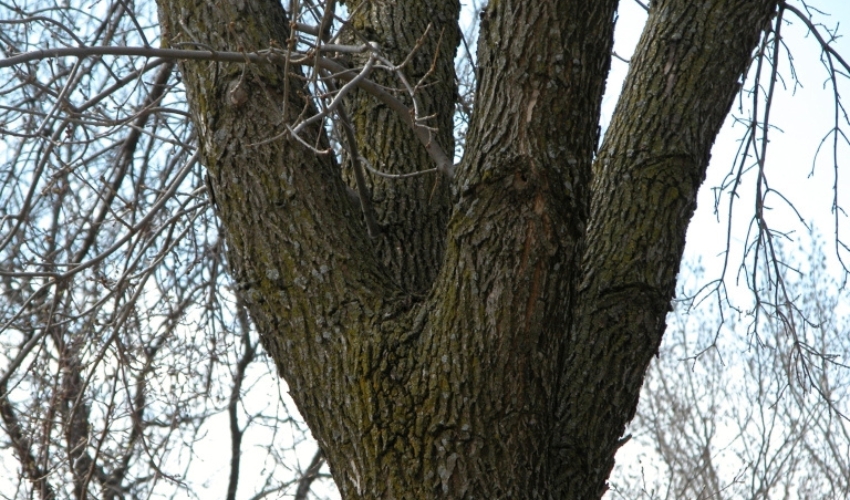
photo by Joseph OBrien, USDA Forest Service, Bugwood.org
Correcting Trees with Co-Dominant Stems
Pruning to establish a single leader is the best way to handle multi-stemmed/co-dominant trees. Select the strongest stem as the main leader and prune off the competing stems. This encourages a single, dominant trunk, reducing the risk of splitting. This is best done when trees are still young.
On older trees, an arborist may recommend cabling or bracing techniques to secure the tree and lower the risk of splitting.
Preventing Co-Dominant Stems
Early intervention is needed to prevent this tree trunk problem from occuring. Regularly inspect young trees and perform proper pruning to encourage a single, strong leader. Removing competing stems early promotes better structure and reduces future risks.
4. Splitting or Cracking Bark
Splitting or cracking in the bark of tree trunks can be a concerning sight. These can appear as deep, vertical lines along the trunk. While a crack in the bark may not be a major concern, a cracked tree trunk could be a major issue, leading to structural weaknesses.
Here are several types of cracks and splits your tree trunk may develop:
- Frost Cracks: Vertical splits that occur when rapid temperature changes cause the bark to expand and contract.
- Sunscald: Damage from intense sunlight, leading to cracked and peeling bark.
- Growth Cracks: Splits resulting from rapid growth spurts.
- Lightning Strikes: Severe vertical cracks due to lightning hitting the tree.
- Mechanical Injury: Splits caused by physical damage from equipment, animals, or storms.
- Girdling Roots: Roots that encircle and constrict the trunk, leading to cracks.
- Canker Cracks: Bark splits caused by fungal infections creating cankers.
- Drought Stress: Cracks forming from prolonged lack of water, causing bark to contract and split.
Fixing Splitting or Cracking Bark
Most smaller cracks in the bark are not a cause for concern. A tree will compartmentalize, blocking off the damaged area, and recover without issue.
For deeper or larger cracks, consult a professional arborist, as larger wounds can open the door to pests or diseases and weaken the trunk. A deep crack in the trunk that goes beyond the outer bark layer should definitely be inspected by an arborist to ensure the tree is stable.
Don’t apply any type of dressing to bark cracks, as these solutions can trap moisture inside and do more harm than good.
Prevention Splitting and Cracking Bark
You can minimize the chances of splitting or cracking bark by maintaining healthy trees and ideal growing conditions through effective watering techniques, mulching to buffer against temperature extremes, and protecting the tree from mechanical injuries.
5. Pest Infestations on Tree Trunks
Pests are one of the most common tree trunk problems we face in Northeast Ohio. Pest damage can weaken trees and make them vulnerable to diseases, decay, and death. Many pests target trees that are already stressed, though some pests will attack perfectly healthy trees.
To identify pest problems, look for signs such as small exit holes, frass (sawdust-like material), and weakened or dying bark. Common pests include borers, beetles, and ants.
Borers, such as emerald ash borers (EAB), do considerable damage to the vulnerable inner bark layers. Peeling off the exterior bark of an infested tree would reveal winding tunnels or galleries carved by the larvae, along with signs of decay and disrupted nutrient flow, which can ultimately lead to the tree’s decline and death.
Treating Pest Infestations
Remove and destroy affected branches to limit the spread of the pest.
Many pests can be managed with insecticides. However, treating trees with insecticides requires knowledge, training, and proper equipment. Most professional arborists will treat
trees with trunk injections, allowing the solution to circulate throughout the tree, repelling or killing the pests from the inside out. Improper application of insecticides can harm or kill a tree or other surrounding vegetation.
Preventing Tree Pests
There are so many different types of tree pests here in Northeast Ohio, and they all target different trees for different reasons. The best thing you can do is ensure maximum tree health and ideal growing conditions. Healthy trees are much less susceptible to pest problems.
But there’s a lot that goes on in the typical residential and commercial landscape. Let your local arborists customize a plant health care (PHC) program for you to keep your plants and trees thriving year-round and take preventive steps to managing pests.
6. Tree Diseases and Fungal infections
Tree trunks are susceptible to various diseases and fungal infections that can weaken and kill the tree. You can tell your tree is sick by noticing symptoms such as
- Spotted leaves
- Discolored bark
- Oozing sap
- Mushrooms growing at the base
- Dead or sunken areas (cankers)
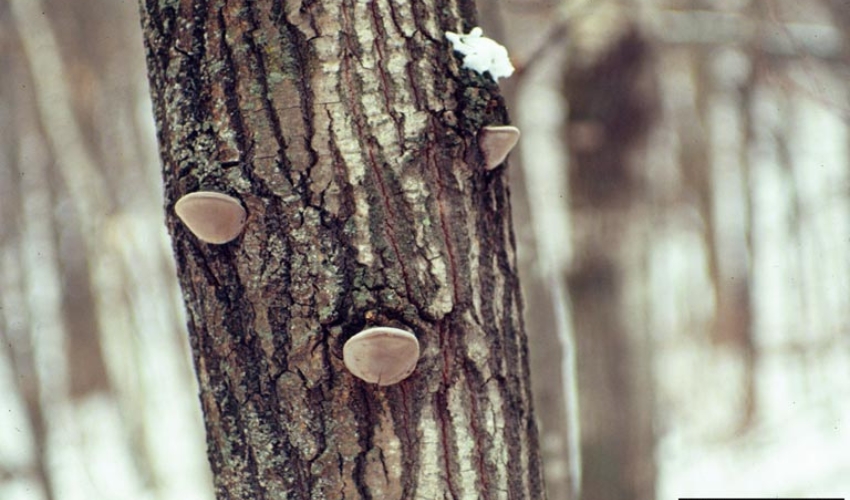
Photo by Joseph OBrien, USDA Forest Service, Bugwood.org
Treating Fungal Infections
Prune and dispose of infected branches to prevent spread. Application of fungicides is effective in fighting many (but not all) tree diseases. For the best chances of success, leave this treatment to professional arborists.
Preventing Fungal Infections
You can help prevent tree trunk fungus by maintaining overall tree health through regular watering and mulching. Ensure good air circulation and soil drainage to reduce moisture
levels that promote fungal growth. Practice proper pruning to maximize air flow and light penetration in the canopy and eliminate conditions that are conducive to fungus.
7. Cankers
Cankers are dead, sunken areas on the bark of trunks or branches, caused by fungal or bacterial infections. While they won’t kill a tree, they can weaken the trunk and provide entry points for pests. Look for discolored, cracked, or oozing bark and sunken lesions on the trunk or branches to determine if your tree has cankers.
Treating Tree Cankers
If cankers develop on branches, you can carefully prune the branch at the branch collar. If a canker is on the trunk, it’s best left alone. The tree will block off the wound on its own.
Larger cankers that may weaken the trunk can’t be remedied and removal may be the only option to prevent tree failure.
Preventing Cankers
The best way to deal with cankers is to prevent them. Keep trees healthy through regular watering, mulching, and proper pruning to reduce stress. Avoid mechanical injuries to the bark, which can create entry points for pathogens which lead to cankers.
8. Included Bark
“Included bark” forms when two branches grow closely together, causing bark to be pinched between them. This weakens the tree’s structure and increases the risk of splitting. You can find included bark by looking for narrow, V-shaped crotches and bark that appears pinched or embedded.
Fixing Included Bark
Prune one of the competing branches to reduce the risk of splitting. For larger trees, professional cabling and bracing may be necessary to provide additional support and prevent breakage.
Preventing Included Bark
Promote strong structure by pruning young trees to encourage a single, dominant leader and wide-angled, U-shaped branch cro
corrective pruning as needed to prevent narrow-angled branches and included bark from developing.
9. Cavities in the Tree Trunk
Cavities are hollow spaces in the trunk, often resulting from decay, mechanical injury, or old pruning wounds. They can compromise the structural integrity of the tree, making it more susceptible to pests and further decay, though most smaller cavities on a tree trunk don’t pose much of a threat.
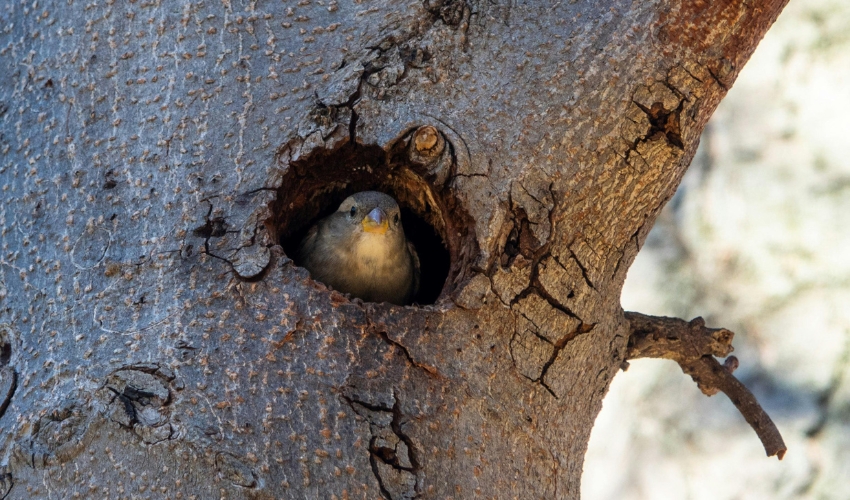
Can You Fix Tree Cavities?
Leave cavities alone, as filling them can trap moisture and worsen decay. Most cavities are not a threat to overall tree health. And they usually become the home of owls, squirrels, or other wildlife.
Preventing Tree Trunk Cavities
You can prevent unsightly cavities by avoiding mechanical injuries to trees. Don’t hit them with a lawnmower. Don’t drill holes into the tree. And make sure to prune branches properly, with a clean cut just outside the branch collar.
10. Excessive Holes in the Trunk
Excessive holes in tree trunks often indicate decay or pest problems. Large holes are indicative of woodpeckers. Smaller holes can often be attributed to pests like borers.
When woodpeckers are present, your tree is likely suffering from both decay and pests. Woodpeckers prefer searching for bugs in soft, decaying trees.
Should You Treat Excessive Holes in the Trunk?
There’s nothing you can or should do to try to remedy any existing holes. Too many holes may mean a tree is dying or already dead, in which case removal may be the best option. Or, if the tree is in a location away from your home, and not at risk of falling on anything, you can leave it standing to be used as a snag to benefit wildlife.
Preventing Holes in the Tree Trunk
Preventing tree decay and pest infestations is the most effective way to prevent woodpeckers and insect pests from drilling countless holes into your tree.
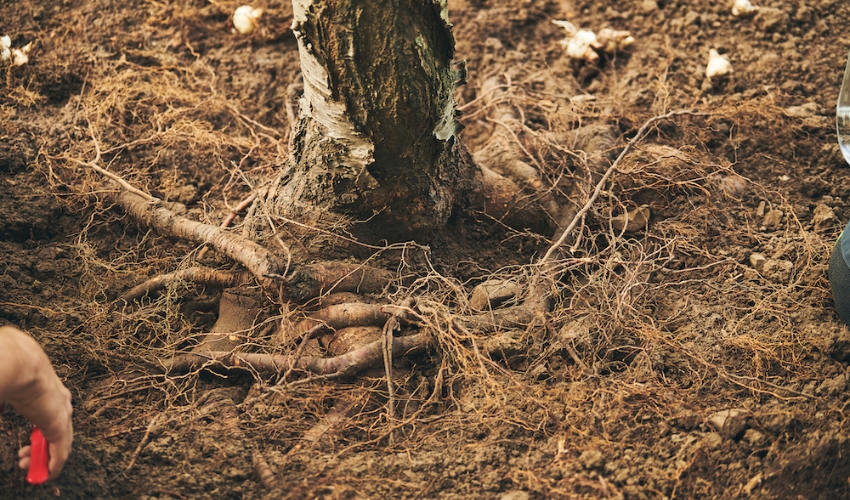
11. Stem Girdling Roots
Roots that encircle the tree trunk (stem girdling roots) can constrict the trunk, disrupting the tree’s nutrient and water flow, leading to poor growth and decline. They also weaken the tree’s structural integrity, increasing the risk of instability and potential collapse.
One of the most common problems is planting a tree that has become “containerized.” When a nursery tree outgrows its container, the roots grow in a circle around the container. When finally planting this root-bound tree, if the roots aren’t first corrected, they will continue to grow in a circular pattern and strangle the tree.
How to Fix Stem Girdling Roots
Depending on the severity of the girdling roots, portions of the roots may be removed to relieve pressure on the trunk. Soil excavation may be necessary first.
It’s important not to remove too many roots. Consult a professional arborist, especially if it’s a valuable tree, to ensure you don’t harm or kill your tree.
Preventing Stem Girdling Roots
You can prevent roots from girdling by planting trees at the correct depth. Don’t pile mulch up against the trunk, as this gives new roots material to grow upwards into, rather than down into the soil. By leaving the root flare exposed, you’ll be able to catch root girdling early, making it easy to remove yourself.
When planting a new tree from a nursery, ensure the roots aren’t growing in a circular pattern. If they are, gently loosen the root ball of the tree before placing it into the ground. Identify the long, circular roots and either straighten them or prune them with clean pruning shears to allow new root growth to push outward.
12. Harmful Vines
Certain species of tree-climbing vines can be attractive. If you’re lucky, they may not harm the tree directly. But some species can be damaging to trees.
Harmful vines, such as ivy and wisteria, can strangle tree trunks and branches, blocking sunlight and restricting growth. Use a guidebook or smartphone app to identify the species of vine on your trees to determine if they should be killed and removed.
Even if a vine is benign, it can cover up trunk defects that may be hazardous. If property owners don’t see these defects, they won’t address them, leading to potential tree death or failure. Also, vines add a lot of weight to a tree which can lead to branch failure. It’s best not to let any vines grow in your trees.
Removing Harmful Vines
Carefully cut and remove vines at the base, being cautious not to damage the tree bark. Allow the remaining vine to die and decompose naturally. Avoid pulling it off, which can cause further harm to branches and bark.
Preventing Harmful Vines on Your Trees
Regularly inspect trees and promptly remove any emerging vines before they can take hold of the tree. They may grow up from the base, or they may reach your tree from other nearby trees, shrubs, or fences.
Tree Trunk Issues? Call Independent Tree!
Healthy tree trunks are vital for the overall health and stability of your trees, ensuring they thrive and enhance your landscape. Addressing trunk issues promptly can prevent costly damage and prolong the life of your trees here in Northeast Ohio.
Call us today at 440-564-1374 for a professional inspection or use our online form to request an estimate for a professional arborist inspection to identify tree trunk issues and recommend options to correct the situation, if necessary.
Tree trunk issues?
Call us today so we can help you identify, prevent and solve your tree trunk issues to save your trees!Recent Articles
Topics
About The Author

STAY IN THE LOOP
WITH OUR
LATEST UPDATES
"*" indicates required fields

